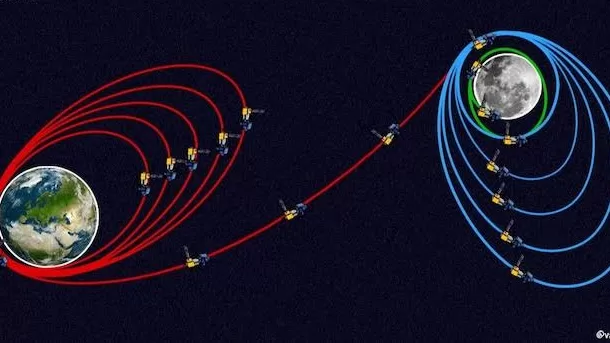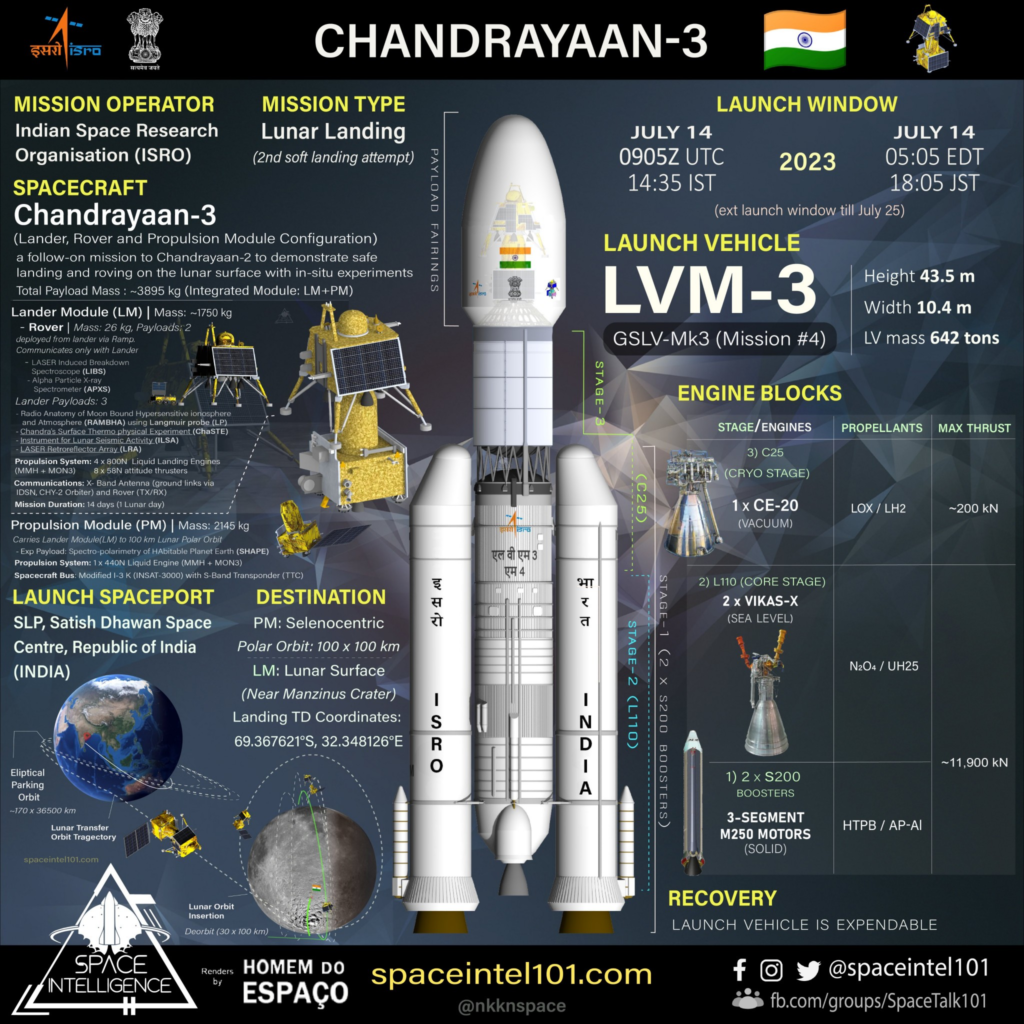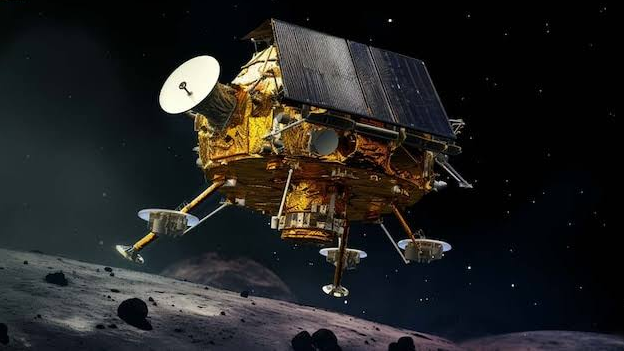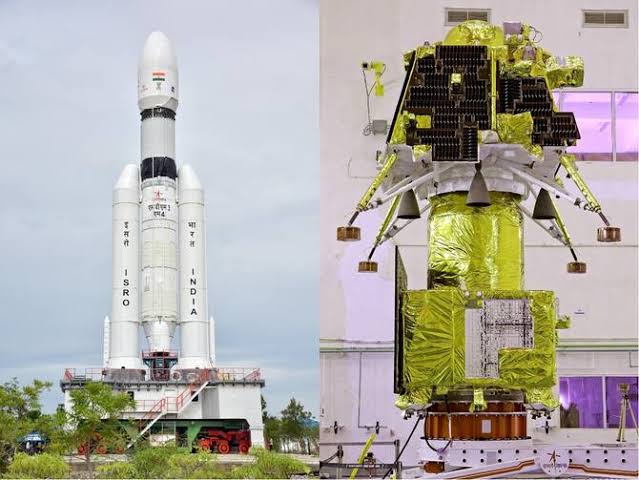The Indian Space Research Organisation (ISRO) is all set to launch its third lunar mission, Chandrayaan 3, on Friday, July 14, 2023. The mission will be launched from the Satish Dhawan Space Centre in Sriharikota, Andhra Pradesh, at 2:35 pm IST.
Chandrayaan 3 is a follow-up to the Chandrayaan 2 mission, which was launched in September 2019. However, the Chandrayaan 2 lander, Vikram, crashed on the lunar surface due to a technical glitch.

Chandrayaan 3 will attempt to soft-land a lander and rover on the Moon’s south pole. The lander will be carrying a variety of scientific instruments, including cameras, spectrometers, and a magnetometer. The rover will be able to travel up to 500 meters on the lunar surface.
The mission is expected to last for one lunar day, which is equivalent to 14 Earth days.
The launch of Chandrayaan 3 is a major milestone for the ISRO. If successful, it will make India the fourth country to soft-land a lander on the Moon’s surface.
The mission is also significant because it will be the first time that a rover will be deployed on the Moon’s south pole. The south pole is of particular interest to scientists because it is believed to contain water ice, which could be a potential resource for future human exploration.
The launch of Chandrayaan 3 is a testament to the ISRO’s growing capabilities in space exploration. The mission is a major step forward for India’s space program and will help to further the country’s scientific and technological prowess.
Here are some of the key objectives of the Chandrayaan 3 mission:
- To soft-land a lander and rover on the Moon’s south pole.
- To conduct scientific experiments on the lunar surface.
- To collect data about the Moon’s geology, composition, and atmosphere.
- To demonstrate India’s capabilities in space exploration.
The launch of Chandrayaan 3 is a major event for India and the world of space exploration. It is a testament to the ISRO’s hard work and dedication, and it is sure to inspire future generations of scientists and engineers.

The Chandrayaan 3 mission is a complex undertaking, and it will involve a number of steps. Here are some of the key steps:

- Launch: The Chandrayaan 3 spacecraft will be launched from the Satish Dhawan Space Centre in Sriharikota, India. The launch is scheduled for July 14, 2023.
- Translunar Injection: Once the spacecraft is launched, it will undergo a translunar injection maneuver. This maneuver will place the spacecraft on a trajectory that will take it to the Moon.
- Lunar Orbit Insertion: The spacecraft will then undergo a lunar orbit insertion maneuver. This maneuver will place the spacecraft in a stable orbit around the Moon.
- Soft Landing: The spacecraft will then attempt to soft-land on the Moon’s south pole. The soft landing is a critical step, and it will be the first time that India has attempted to soft-land a spacecraft on the Moon’s south pole.
- Rover Deployment: Once the spacecraft has landed, the rover will be deployed. The rover will be able to travel up to 500 meters on the lunar surface.
- Scientific Experiments: The spacecraft and the rover will carry a variety of scientific instruments. These instruments will be used to conduct scientific experiments on the lunar surface.
- Data Collection: The spacecraft and the rover will collect data about the Moon’s geology, composition, and atmosphere. This data will be returned to Earth and analyzed by scientists.
- Mission Termination: The Chandrayaan 3 mission will terminate after one lunar day, which is equivalent to 14 Earth days.

These are just some of the key steps involved in the Chandrayaan 3 mission. The mission is a complex undertaking, but it has the potential to make significant scientific discoveries.
The Chandrayaan-3 spacecraft is scheduled to launch on July 14, 2023, at 2:35 PM IST. If the launch is successful, the spacecraft will reach the Moon’s south pole in about 45-48 days. The soft landing on the Moon is scheduled for August 23-24, 2023.

The Chandrayaan-3 mission is a follow-up to the Chandrayaan-2 mission, which was launched in September 2019. However, the Chandrayaan-2 lander, Vikram, crashed on the lunar surface due to a technical glitch.
Chandrayaan-3 will attempt to soft-land a lander and rover on the Moon’s south pole. The lander will be carrying a variety of scientific instruments, including cameras, spectrometers, and a magnetometer. The rover will be able to travel up to 500 meters on the lunar surface.
The mission is expected to last for one lunar day, which is equivalent to 14 Earth days.
The launch of Chandrayaan-3 is a major milestone for the ISRO. If successful, it will make India the fourth country to soft-land a lander on the Moon’s surface.
The mission is also significant because it will be the first time that a rover will be deployed on the Moon’s south pole. The south pole is of particular interest to scientists because it is believed to contain water ice, which could be a potential resource for future human exploration.
The launch of Chandrayaan-3 is a testament to the ISRO’s growing capabilities in space exploration. The mission is a major step forward for India’s space program and will help to further the country’s scientific and technological prowess.

